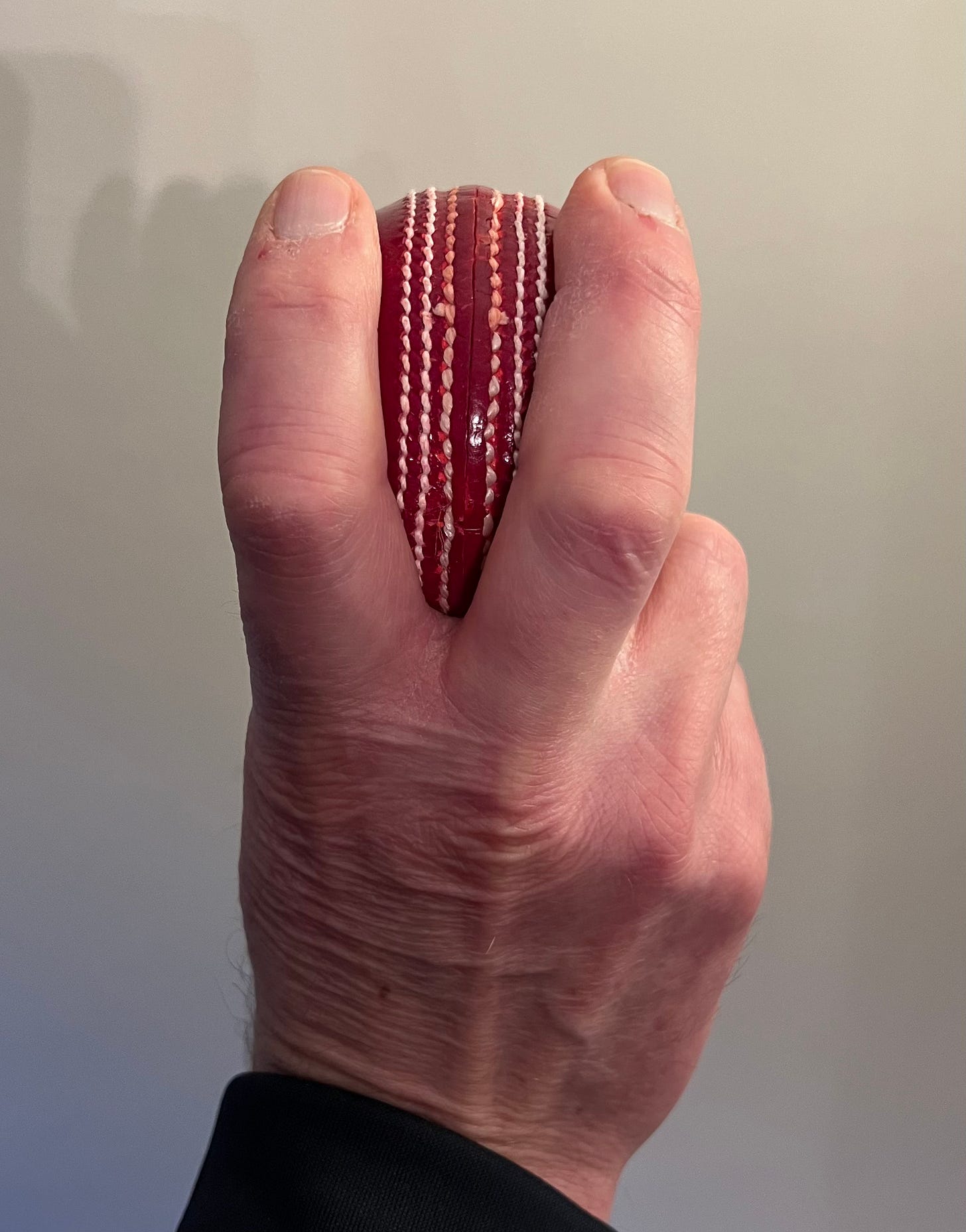The Wobble Seam: Jofra Archer Taught Us A Valuable Lesson That Hardly Anyone Noticed
Let's dive deep into mastering the intricacies of the "wobble seam".

Every couple of years, I'm gripped by Ashes fever.
One memorable moment for me a few years ago was how frighteningly quick Jofra Archer was in his debut series for England.
During the 2019 Lord's Test against the Australian batters on a good wicket with a ball that wasn't doing much, Jofra, for short bursts, was used tactically for outright pace.
His top speed was 96mph, sconning both Steve Smith, who had to retire hurt, and Marnus Labuscagne, his concussion replacement.
It was a petrifying pace.
Nevertheless, later in the series, there was a noticeable shift.
The conditions changed during the next test match, which was Headingly. It was still an excellent hard surface, but this time, it had live green grass.
I noticed Jofra do something very deliberate, much to the dismay of the commentary team, who questioned why his speed was down.
I noticed Archer drop his pace dramatically to suit the conditions of the match, and it was a fascinating example of somebody choosing the wobble seam to nip the ball off the noticeably green surface.
He chose to bowl in the early to mid-80s instead of 90 plus miles per hour, which led to people mistakenly questioning his commitment.
His skill on this occasion was presenting an upright seam with a slight canter to get nip off of the live green grass in the hope of either hitting the string of the seem to achieve a reaction sideways or for the ball to hit the leather and skid on.
It was an excellent option in those conditions because Archer returned career-best figures of 6/45 (17.1 overs), and England won the test match.
Whatever level you play, I'll show you how to maximise this ball in your cricket.
Let's dive in.
Bolt Upright
Perfecting the art and skill of presenting a bolt-upright seam with no wobble is ground zero for seam bowlers at any level.
It can take years to get this right.
As a club cricketer, you can make a substantial improvement to your game by just having some quality monitoring controls in place to measure this.
Make sure you bowl with one of those half-and-half red and white balls or a ball with tape on the seam every training session.
Then you get somebody to stand on a chair where the umpire would typically stand to take some high speed footage, allowing you to check your seam presentation.
It's simple stuff, but it's also easy not to do.
Mastering the upright seam is crucial for achieving lateral movement and is usually the point of difference in a bowler's success.
That's why you want to tick that box in every training session: once you've perfected that bolt upright, with no wobble of the seam presentation, you can choose to bowl swing or seam.
For the sake of this blog, we're diving into the seam part and, mainly, how a slight wobble can have a dramatic impact.
Let's go.
The art of the wobble.
Every game of cricket starts with a new ball, which is rock-hard.
The seam position dictates the airflow depending on which way the ballpoints, or the bowler's natural action will dictate whether it's outswing or in the swing.
But here's the thing.
Once you present an excellent upright seam, you can swing the ball and also get lateral movement off the pitch through the seam.
If there's no movement in the air, your alternative option is to induce some deviation off the pitch. This is where executing a well-practised wobble seam can be a highly effective option.
The feel-through release with a wobble seam should feel the same as your stock ball where you're aiming for swing.
Try to avoid skim-reading this part because the details are essential.
You've got two options to make the seam wobble slightly from release.
One is you increase the distance between your fingers on top of the ball in your grip, and as you release the ball, because your two fingers are slightly further apart, that puts a little wobble on the seam.
If you impart a slight wobble, the ball still has a chance of swinging, as long as it's only a subtle wobble.
Once the ball makes contact with the surface due to the wobble, it can deviate or nip in either direction if it nicks either side of the seam or the area where the string meets the leather.
So, you have both options of swing and nip up your sleeve.
The other way to achieve a wobble seam is also in your grip, but this time to slightly canter the ball one way or the other.
Position your fingers where they usually are for your stock delivery when they align with the seam. But this time, gently twist the seam by creating a slight tilt, adjusting its direction.
It'll feel noticeably different in your hand, but the specific feel of the seam in your grip and the sensation upon release should be similar to your stock ball.
Final Touches Of Release.
This final execution piece is crucial.
You want to ensure that during those last milliseconds at the top of your action and during release, your fingers are still looking to rip down hard and through the back of the ball at your optimum pace.
Because you've cantered the seam slightly (tilted or angled), it will wobble after release, but you're only looking for a slight wobble, so it nicks one side of the seam or the other.
With lateral movement possible in both directions, your bowling line should aim to target the stumps to bring all modes of dismissal into play.
A slight wobble creates uncertainty for the batter, who won't know how the ball will deviate.
However, unlike conventional swing, the "wobble seam" deviation occurs much later in the ball's trajectory down the wicket, so a well-executed wobble seam delivery can be highly effective.
If it's gun barrel straight at middle and off stump, you have bowled, LBW and caught behind all in play.
A great example of somebody choosing the wobble seam or nip off the surface instead of pace and swing was when Joffra Archer executed it at Headingley.
It's becoming an effective delivery because it’s harder for batters to face, and the statistics support that it gives you better rewards.
The art of executing the wobble seam still starts with bowlers having the skill of presenting an excellent upright seam.
Just this time, your fingers are vertical to the seam, pulling down and through the back of the ball through their release.
Final Thoughts.
In first-class cricket, batters against a ball that moves 1.5 degrees or more in the air average 26.7.
But against balls that move off the pitch, i.e., wobble seam deliveries with at least 0.75 degrees of movement, the batting average is 20.
That’s half the amount of movement, but the data reflects that it’s significantly harder to face
If you've got a bowler in your team who can swing the ball, it could be a league-winning secret weapon if they can make that transition by developing the wobble seam ball.
It could be you.
Be mindful that this strategy relies on a hardball because the surface needs to react to the string on the ball.
So, as a bowler, you want your fielders to keep the ball as hard as possible with good maintenance.
Keep scuffs off the ball by making sure fielders throw it straight into the keeper's gloves on the full, avoiding throws on the one bounce in those early overs.
I have always found appointing a ball manager on match days useful. Get the ball to the ball manager, who will shine one side and get mud out of the seam.
Understand that live green grass is good for seam or nip, and you always want to challenge the stumps to keep all modes of dismissal in play.
This skill is difficult but can produce outsized results for any bowler.
The only question to ask now is, why not you?






Good one thanks .. falling that I revert to boring them to death!off side field and keep runs down
Hi Stuart I mentioned before I bowl cross seem ..I call it anyway.. to add ..if the wicket is hard and some bounce I can get it to nip away a bit as well as green and damp .. but not a lot off dry slow wickets